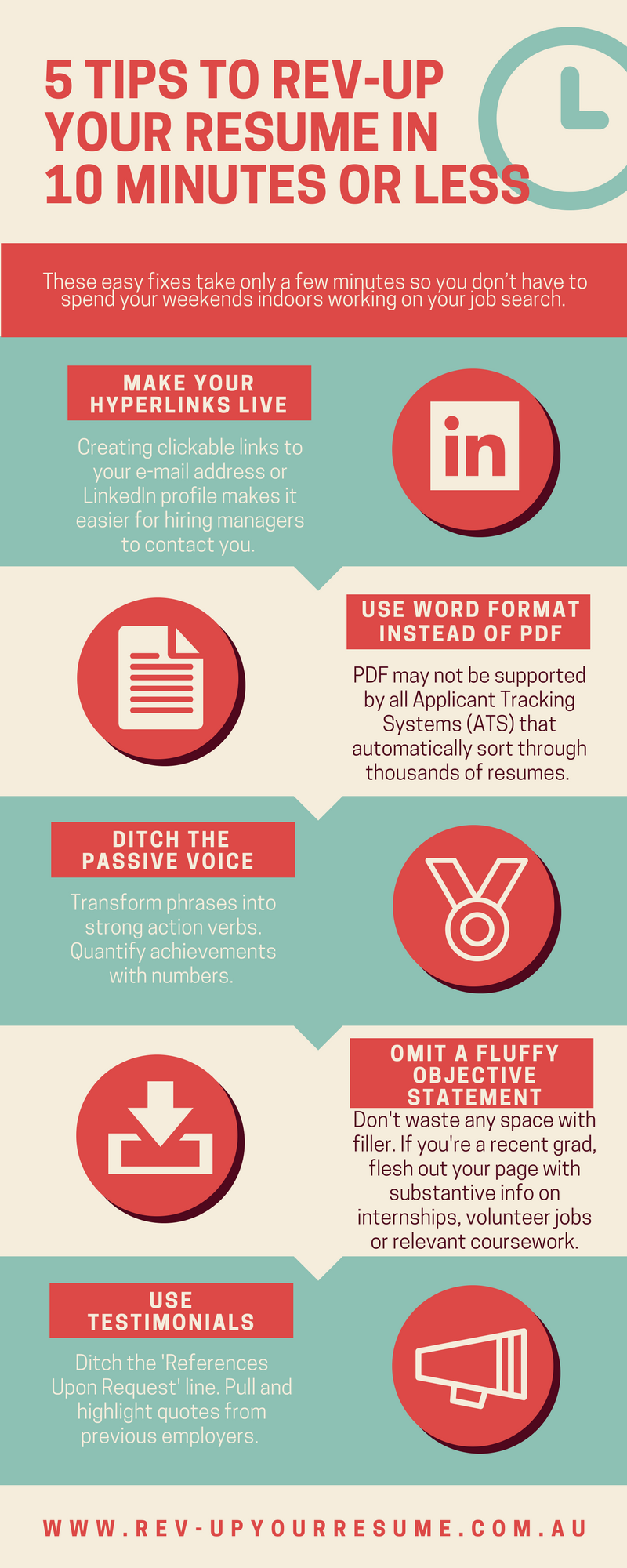As the most vital tool in your job search, you need to ensure that your Australian resume (or Australian CV) makes an impact, stands out, and ultimately lands you an interview. Your resume won’t accomplish any of these unless it is contemporary, up-to-date and follows the latest trends in resume writing.
If you’re about to start a new job search, you need to get your resume up-to-speed. So before you submit your application, review the quick tips below. These easy fixes take only a few minutes so you don’t have to spend your weekends indoors working on your job search. Here are five to try that should make your resume more effective — in 10 minutes or less.
1. Make Your Hyperlinks Live
Creating clickable links to your e-mail address, LinkedIn profile and any other social media links makes it easier for recruiters or hiring managers to contact you. Additionally, it helps them get to know you better than the relatively little information they can gather from your resume.
Be proactive and offer links to your social media profiles so potential employers don’t have to waste time seeking them out. Apply caution though! Before sharing these links, be sure that your profiles reflect the professional image you want employers to see.
2. Send your resume in MS Word
It’s best to use Word Doc instead of a PDF format primarily because PDF is likely not supported by all Applicant Tracking System (ATS) software. Nowadays, majority of companies use ATS systems to mechanically sort through thousands of resumes that come their way.
Currently, there are about 55 different ATS vendors in the market, of which only a few are able to translate the information from your PDF resume into their system. Hence, if your resume is in PDF form, there’s a chance that the ATS will not be able to read it.
Also, use the extension ‘.doc’ and not ‘.docx’ when saving your resume in MS Word. This is to ensure that employers with older MS Word versions would still be able to open your file.
3. Use Active Voice
A list of tasks you completed doesn’t convey what was unique or interesting about your contributions. Hence, listing specific accomplishments is one of the best ways to make your resume stand out. Use active verbs rather than passive ones for describing your past achievements.
Superfluous words like “responsible for,” “oversight of,” and “duties included,” unnecessarily complicate and hide your experience. Be direct, concise, and use active verbs to describe your accomplishments. Combine action words with numbers to quantify your achievements.
Here’s the difference:
Example of passive: Responsible for increasing sales.
Example of active: Grew sales by $1M.
It might not seem like a huge difference, but when you’ve got just a few seconds of a hiring manager’s time, the second one is significantly more attention grabbing.
4. Omit a Fluffy Objective Statement
As a ‘prime real estate,’ you shouldn’t waste any space in your resume with filler. For instance, instead of simply saying that you’re ‘results-driven,’ write about what you did to actually drive results — and what those results were. Also, writing ‘hard-worker’ wouldn’t necessary convince hiring managers of your efforts. Rather, provide concrete examples of how you’ve gone the extra mile in place of a non-memorable cliché.
Replace your objective statement (which usually talks about the type of job you wanted for YOURSELF) with a personal statement (or professional profile). It is a 3-4 sentence introductory paragraph that summarises your skills, experience and accomplishments you can transition to a new role.
If you’re a recent graduate who don’t have a lot of professional experience under your belt, flesh out your page with substantive information about internships, volunteer jobs or even relevant classwork that shows skills that will translate in the workplace.
5. Use Testimonials Instead of ‘References Upon Request’
LinkedIn lets you put recommendations on your profile, so this tip extends the idea to your paper resume. If you’ve kept copies of performance reviews, the testimonial section is a great place to include a few positive highlights from your manager. You don’t have to include a full paragraph, just a sound bite or two.
Reserve the list of references down the hiring process when someone asks you to provide this. Usually, the fact that the employer asks for your references is a good sign because it’s typically requested from the shortlisted candidates. This means that you’ll most probably need your references ready for the later interview circles, though not on the resume itself. Be careful though as some job posting explicitly requests your references to be stated in your resume. In this case, be sure to include them or you may be disqualified from the further process.
This post was originally published on (14 April 2017) and updated on (10 October 2019).



One thought on “5 Quick Tips to Writing a Winning Resume”
Comments are closed.